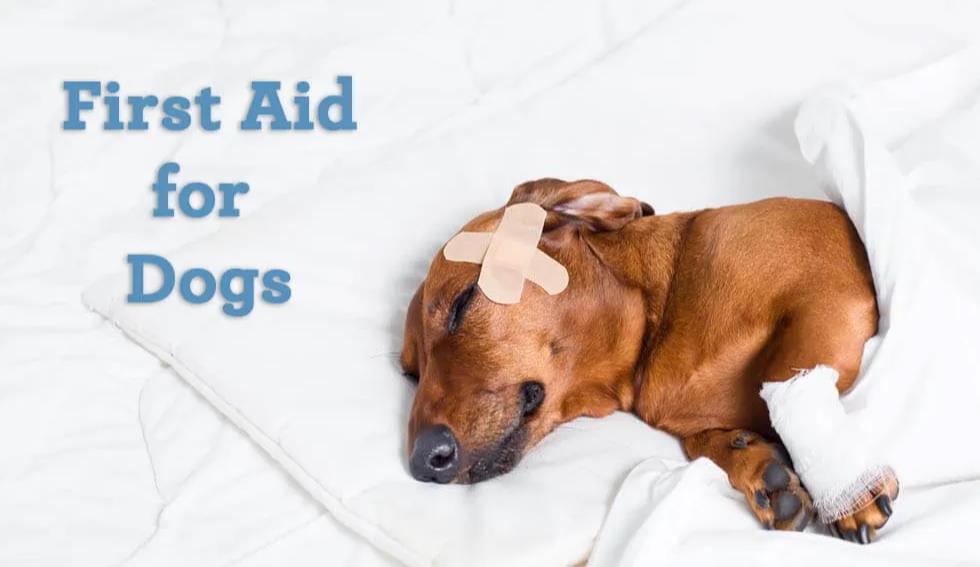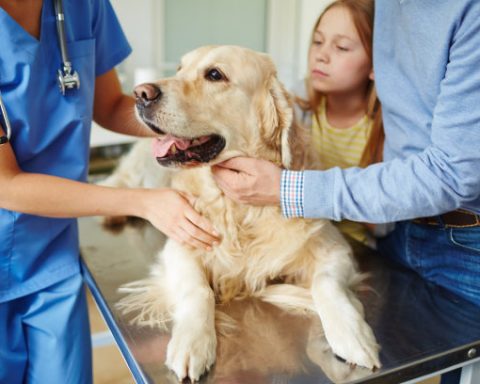Dressing of eye wounds: Cover the eye with sterilized gauze soaked in warm water and wrap a bandage around the head.
Foot bandage:
- Stuff the toes with cotton, then wrap the whole foot with cotton.
- Wrap with a bandage and stick it on.
- Cover with plastic tape, then put on socks and tape.
Trauma and burns
The most common traumas are bites from dog fights and cuts to the feet. If there is blood on the dog’s fur, find the site of the bleeding, and touch the hair clumps (blood clots) when the bleeding is not obvious.
Disposal methods:
- Shave the hair if necessary to expose the wound.
- Stop the bleeding.
- Put on a bandage.
- In case of shock, follow the treatment of shock.
- Notify the veterinarian.
Treatment of burns:
Causes:
- Dip into corrosive liquid.
- Falling into hot tub.
- Biting electric wires.
- Frostbite.
Disposal method:
- Use cold water to flush away the corrosive liquid.
- Apply petroleum jelly and other mineral oils.
- In case of shock, treat according to the treatment of shock.
- Notify the veterinarian.
Control bleeding:
Cover the wound with a piece of sterilized gauze, wrap it tightly with a bandage, and if the blood flow is not stopping, use the bandage to press the following positions:
- Forelimb: Brachialartery (upper shoulder artery) on the inside of the elbow.
- Hind limb: Femoral artery (femoral artery) on the inside of the thigh.
- Tail: Coccygealartery (caudal artery) on the ventral surface of the tail.
- Head and neck: The carotid artery, which lies between the neck and the shoulder notch, is pressed firmly with the fingers.
Poisoning
There are not many cases of poisoning in dogs. Dogs do not sift food as well as cats, and sometimes ingest harmful substances. Dogs will also lick harmful substances on their fur, and the signs of poisoning are:
- acute vomiting
- collapse
- Rapid muscle twitching
- Rigor mortis
- Weakness
- Hemorrhage treatment:
- Rinse the hair to prevent more harmful substances from entering the dog’s body.
- Notify the veterinarian immediately.
- If the dog is known to have swallowed something, bring it and the container to the veterinarian. If the veterinarian asks you to make the dog vomit with an emetic first, this is usually only effective if the dog vomits within 30 minutes of eating the toxic substance. Commonly used emetics include sodium carbonate, salt and mustard.
The foreign body is in the mouth:
Stop the dog from scratching the eyes, if necessary, wrap the paws with cotton or cloth, hold the dog tightly, and the other person will use the index finger and thumb to hold the eyelids open, if the foreign body has been inserted into the eyes, do not touch and immediately send to the doctor, if the foreign body is just sticking to the surface of the eyes, the available physiological saline irrigation, to flush out the foreign body.
Foreign body in the throat: when there is a piece of wood or a ball stuck in the throat or trachea, the dog will have difficulty breathing and will die if not removed in time. Try drowning first aid to remove the foreign body, if not effective, please send to the hospital immediately.
Heatstroke: keep the dog in a closed car, the dog is very easy to heatstroke, if it is not too late, the dog is still conscious, in the hard panting, mouth with foam:
- Remove the foam from the nose and mouth. 2.
- Sprinkle cold water all over the dog’s body.
- Take the dog to a doctor immediately.
Drowning
As soon as the dog comes to shore, expel the water in the lungs.
Small dogs can be lifted up by the hind legs so that the dog is in a head-down position, and another helper will open the mouth and squeeze the chest.
For large dogs, carry the dog on your shoulder with the dog’s belly against the shoulder, the dog’s head down, open the mouth wide and squeeze the chest.
Twitching
The most common cause of convulsions is epileptic seizures, in which the dog appears rigid and convulsive, and before the seizure the dog appears agitated, the main signs being:
- Teeth clenching and chewing.
- Contraction of the lips backward.
- Foaming of the mouth.
- Failure and coma.
- Discharge of feces and urine.
- Stirring of the legs.
Disposition:
- If it is known that the dog is not epileptic and is having convulsions, notify the veterinarian immediately. If the seizure is epileptic, treat the dog in the following way.
- Place the dog in a safe, undisturbed and comfortable place. 3.
- Uncollar the dog, cover with a blanket if necessary, and avoid touching the dog until the seizure subsides.
- Keep the room dark and quiet.
- The seizure lasts about 5 minutes, after which the mouth, nose, feces and urine should be cleared.
- Give water, but reduce the amount of food; rest in a quiet environment. 7. Follow your veterinarian’s instructions for medical attention.
Shock and exhaustion
When a dog goes into shock or failure, quick and appropriate action can save the dog’s life. The causes of failure are:
- Seizures.
- Acute infection.
- Heart disease.
- Poisoning.
- Diabetes.
- Heat stroke.
- Car accident.
- Bleeding.
Handling of failure:
- Treatment of shock: In shock, the blood pressure is lowered, the heartbeat and respiration are rapid and weak, and the skin is pale and cold. Dogs in shock need to be kept quiet and warm, and can be placed on a hot pad wrapped in a bath towel.
- Check respiration: If breathing is weak, irregular or stops, immediately:
- a. Undo the collar.
- b. Dig open the mouth.
- c. Remove saliva, blood, vomit or any foreign objects from the mouth.
- Breathe through the mouth.
- Check for a pulse: If a pulse cannot be detected, check for a heartbeat directly on the left side of the chest near the back of the elbow. If there is no heartbeat, do a “heart massage”.
- “Heart Massage”: Squeeze the heart on the left side of the chest behind the elbow once a second. (If the heart stops beating for more than 5 minutes, it will cause irreversible brain damage.) After the heartbeat is restored, do artificial respiration.
- Treatment of bleeding: Stop bleeding immediately.
- Support and immobilize the fracture.
- Notify the veterinarian.
Artificial respiration:
- Remove any fluid or foreign matter from the airway, open the mouth and pull out the tongue.
- Place both hands on the ribcage area of the chest and press downward to push air out of the lungs, immediately release the hands so that the chest springs back into place and the lungs expand to draw air in.
- Repeat the above action every 5 seconds.
The basic principles of first aid for humans and dogs are the same. First aid can save a dog’s life, prevent the situation from deteriorating and help to recover quickly, please remember the basic principles of first aid, when you do first aid, you will not have time to consult books, but also please prepare a home first aid kit for backup.
First Aid Steps for Car Accidents
- 1. Don’t be frightened, approach the dog carefully and speak in a quiet tone (preferably by the owner).
- 2. Gently use a rope or leash to immobilize the dog.
- Use the rope to make a sleeve to tie the dog’s mouth as follows:
- a. Tie a knot in the center of the rope and then make a sleeve.
- b. Put the “sleeve” over the dog’s mouth and tie it tightly with a knot.
- c. Wrap the rope around the lower jaw to the back of the head, tie the knot tightly, scared or injured dog will bite, tied to prevent the mouth.
- 4. Check that the dog is properly “muzzled” and that there is no breathing difficulty.
- 5. Perform first aid: check for heartbeat, breathing, hemorrhaging, panting, broken bones.
- 6. Notify the veterinarian.
- 7. Move the dog carefully

